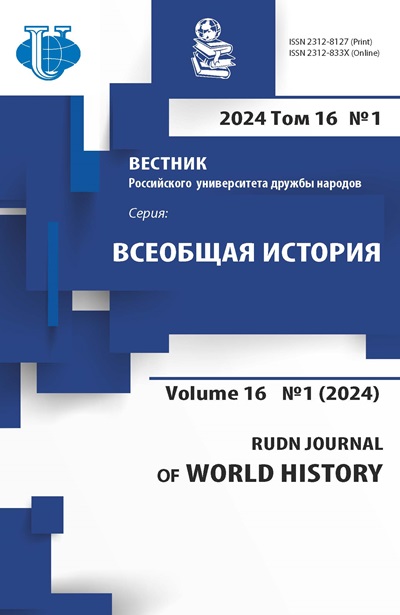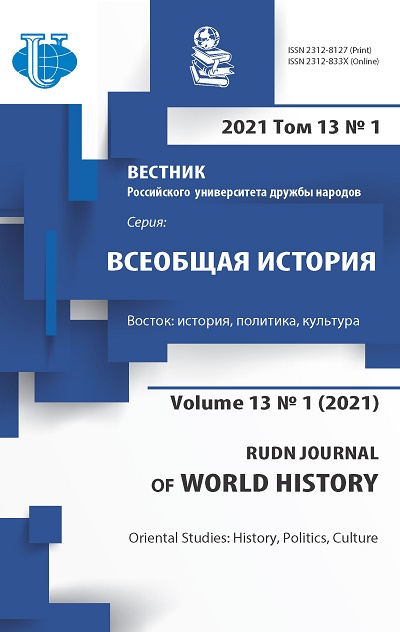Funeral Epitaph of Zhao Rugua (1170-1231), the Author of Zhufan zhi (“Records of Foreign Peoples”; 1225). Structural-Descriptive and Archaelogical Analysis of the Source
- Authors: Zaitsev I.A.1, Kolnin I.S.2
-
Affiliations:
- The Institute of Asian and African Countries at Lomonosov Moscow State University
- The Institute of Oriental Studies of the Russian Academy of Sciences
- Issue: Vol 13, No 1 (2021): Oriental Studies: History, Politics, Culture
- Pages: 77-95
- Section: Studies on Chinese history
- URL: https://journals.rudn.ru/world-history/article/view/25727
- DOI: https://doi.org/10.22363/2312-8127-2021-13-1-77-95
Cite item
Full Text
Abstract
The present work is a continuation of two previously published articles in which the biography of Zhao Rugua 趙汝适 (1170-1231), the author of Zhufan zhi 諸蕃志 (“Records of Foreign Peoples”; 1225) an important historical geographical source about the foreign lands during the Song dynasty (960-1279), was studied through the usage of the text of his funeral epitaph as well as other historical sources. They also included the translation of the text of inscription into Russian and English [1; 2]. The goal of this article is to deepen the study of Zhao Rugua’s funeral epitaph by researching the material features of the source, analyzing the structure of the text and comparing it with other similar sources of Medieval China. In contrast with the previous works the inscription in this article is analyzed both as a textual source and as an object of material culture which enables to understand the context of the creation of the source as well as the extent of detalization of the deceased’s biography.
Keywords
About the authors
Ivan Alexeevich Zaitsev
The Institute of Asian and African Countries at Lomonosov Moscow State University
Author for correspondence.
Email: gorniy_strannik@mail.ru
postgraduate student at the Institute of Asian and African Studies
11, Mokhovaya str., Moscow, Russian Federation, 125009Ilia Sergeevich Kolnin
The Institute of Oriental Studies of the Russian Academy of Sciences
Email: minmi98@yandex.ru
research assistant at the Chinese department of IOS RAS; magister student at the National Research University “Higher School of Economics”
12, Rozhdestvenka str., Moscow, Russian Federation, 107031References
- Kolnin IS. Biografija Chzhao Zhugua, avtora vazhnejshego opisanija inozemnyh stran XIII v. [Biography of Zhao Rugua, the Author of the Most Important Description of the Foreign Countries in the 13th Century]. Obshestvo i Gosudarstvo v Kitae. 2019; (49). (In Russ.).
- Kolnin IS. Some thoughts on Zhao Rugua’s biography and Zhufan zhi: translation and comparison of relevant fragments from various sources // Crossroads – Studies on the History of Exchange Relations in the East Asian World. 2019; (17).
- Ulyanov MYu. «Chzhu fan’ chzhi» («Opisanie inozemnyh stran») Chzhao Zhugua – vazhnejshij istoriko-geograficheskij istochnik kitajskogo srednevekov’ja. [«Zhu fan zhi» («The Description of Foreign Countries») by Zhao Rugua – the Most Important Historical Geographical Source of Medieval China]. Moscow: Vostochnaja literatura, 2019 (In Russ.).
- Ditter A. The Commerce of Commemoration: Commissioned Muzhiming in the Mid to Late Tang. Tang Studies. 2014; (34): 21–46. doi: 10.1179/0737503414z.00000000012.
- Rodin SA. Japonskie epitafii-bosi (VIII v.) [Japanese Epitaphs Boshi (8th c.)]. In: I.S. Smirnov, editor. History and Culture of Traditional Japan 2 (Works of Institute for Oriental and Classical Studies, Vol. XXIX). Moscow: RGGU; 2011. (In Russ.).
- De Groot JJM. The Religious System of China: Its Ancient Forms, Evolution, History and Present Aspect, Manners, Customs and Social Institutions Connected Therewith. Vol. 3. Leiden: Brill, 1897.
- Bossler B. Powerful Relations: Kinship, Status, and the State in Sung China (960–1279). Cambridge: Council on East Asian Studies, Harvard University, 1998. doi: 10.1163/9781684170234.
- Tackett N. The Destruction of the Medieval Chinese Aristocracy. Cambridge: Harvard University Press, 2014. doi: 10.1163/9781684170777.
- Schottenhammer A. Grabinschriften in der Song–Dynastie. Heidelberg: Edition Forum, 1995.
- Schottenhammer A. A Buried Past: The Tomb Inscription (Muzhiming) and Official Biographies of Wang Chuzhi (863–923). Journal of the Economic and Social History of the Orient. 2009; (52). doi: 10.1163/156852009x405339.
- Davies T. Entombed Epigraphy and Commemorative Culture in Early Medieval China: A History of Early Muzhiming. Leiden: Brill, 2015. doi: 10.1163/9789004306424.
- Fong M. Tang Line-Engraved Stone Reliefs from Shensi. Ars Orientalis. 1987; (17).
- Kryukov MV., Malyavin VV., Sofronov MV. Kitajskij etnos v srednie veka (VII–XIII vv.). [Chinese Ethnos in Medieval Times (VII–XIII cc.)]. Moscow: Nauka, 1984. 336 p. (In Russ.).
- Munkuyev NTs. Kitajskij istochnik o pervyh mongol’skih hanah. Nadgrobnaja nadpis’ na mogile Eljuj Chu-caja. [Chinese Source about the First Mongol Khans. Funerary Inscription on the Tomb of Yelü Chucai]. Moscow: Nauka, 1965. 224 p. (In Russ.).
- Dmitriev SV. Samyj vlijatel’nyj hristianin mongol’skoj imperii. Problemy rekonstrukcii biografii inozemca na mongol’skoj sluzhbe [The Most Influential Christian of the Mongol Empire. Problems of Reconstruction of a Biography of a Foreigner at the Mongol Service]. Obshestvo i Gosudarstvo v Kitae. 2005; (35). (In Russ.).
- Xu Sanjian 徐三见. Zhejiang Linhaishi faxian Songdai Zhao Rugua muzhi 浙江临海市发现宋代赵汝适墓志 [Discovery of an Entombed Epitaph of Zhao Rugua of the Song Dynasty in Zhejiang Province, Linhai City]. Kaogu 考古. 1987; (10). (In Chinese).
- Escher JB. New Information on the Degree of “Sinicization” of the Tuyuhun Clan during Tang Times through Their Marriage Alliances: A Case Study Based on the Epitaphs of Two Chinese Princesses. Journal of Asian History. 2019; (53). doi: 10.13173/jasiahist.53.1.0055.
- Mayers WF. The Chinese Government. A Manual of Chinese Titles, Categorically Arranged and Explained, with an Appendix. Shanghai: Kelly and Walsh, 1897.
- Papelitzky E. Historical Geographical Texts of the Late Ming (1368–1644) and China’s Maritime History [Dissertation]. Salzburg; 2017.
- Adamek P. Good Son is Sad If He Hears the Name of His Father: The Tabooing of Names in China as a Way of Implementing Social Values. Sankt-Augustin – Leeds: Routledge, 2015. doi: 10.4324/9781315093475.
- Chaffee J. Branches of Heaven: A History of the Imperial Clan of Sung China. Cambridge – Massachusetts – London: Harvard University Asia Center, 1999. doi: 10.2307/j.ctt1tg5hvk.
- Ouyang Xiu 歐陽修. Song shi. Di shisan ce 宋史. 第十三册 [History of the Song Dynasty. Vol. 13]. Shanghai: Hanyu dacidian chubanshe 漢語大詞典出版社, 2004. (In Chinese).
- Hucker CO. A Dictionary of Official Titles in Imperial China. Stanford: Stanford University, 1985.













